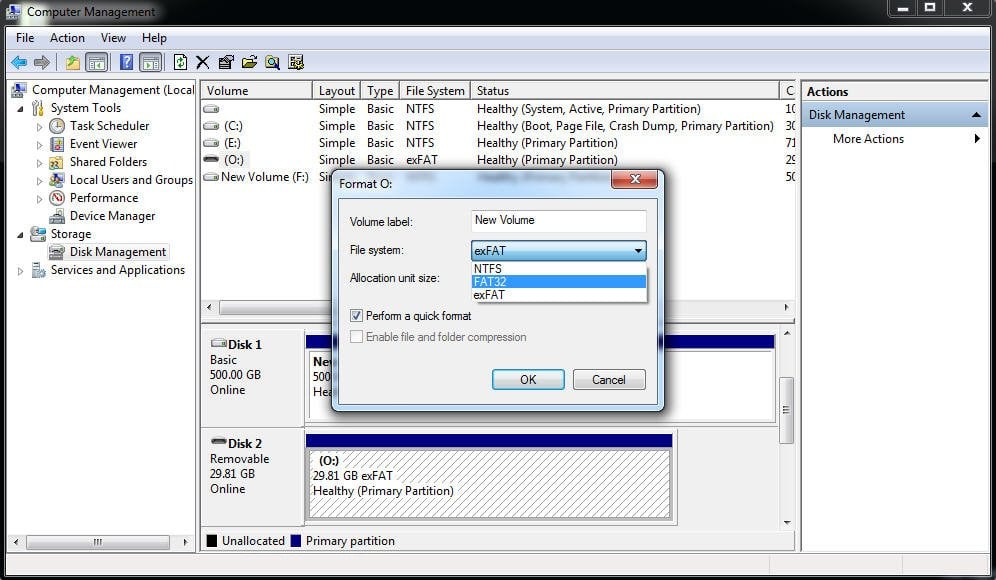
Once the formatting is complete, you’ll see an icon for your flash drive appear on your Mac’s desktop. This option is at the top of the Disk Utility window.Ĭlick Erase, then click Erase when prompted. It’s on the far-left side of the Disk Utility window.Ĭlick the “Erase” tab. You’ll likely find this option in the middle of the Utilities page.Ĭlick your flash drive’s name. This option is in the Go drop-down menu.ĭouble-click “Disk Utility”. If you don’t see Go, first click the Finder icon, which resembles a blue face in your Mac’s dock.Ĭlick “Utilities”. It’s a menu item in the top-left side of the menu bar. Note: Some Macs don’t have USB ports, so you’ll need to purchase an adapter.Ĭlick “Go”. Your flash drive has successfully been formatted.
Format flash drive exfat windows#
Doing this will cause Windows to begin formatting your flash drive for you.Ĭlick “OK” when prompted. If you’ve formatted your drive before and you’re positive that it isn’t broken, you can also check the Quick Format box.Ĭlick Start, and then click OK. By default, the setting for formatting your drive is set to Quick Removal. Right-click the drive and select Properties. Open the Device Manager and find your USB drive under the Disk Drives heading. Note: exFAT format USB flash drives do not work with ClonerAlliance products.Ĭlick a format option (FAT32 or NTFS). To enable NTFS on your USB Flash Drive drive (USB Flash Memory) click on My Computer (This PC) and select Manage. Works with most computers and gaming consoles. If you’re using your drive as a secondary Windows drive, you’ll need to choose this option.įAT32 - The most widely compatible format. NTFS - The default Windows operating system format. A drop-down menu will appear with the following options: It’s below the “File System” heading near the top of the page. Doing so opens the Format window.Ĭlick the “File System” box. This option is near the middle of the drop-down menu. But if the drive is larger than 32GB, you may find that there is only NTFS file system option. It’s beneath the “Devices and drives” heading in the middle of the page.Ĭlick Format. When you format a drive using File Explorer or Windows Disk Management, if the drive is smaller than 32GB, there are FAT32 and NTFS format options. If you’ve formatted your drive before and you’re positive that it isn’t broken, you can also check the Quick Format box. Note: exFAT format USB flash drives do not work with ClonerAlliance products.

The drive, so make sure you back up your files before formatting yourĬonnect the USB flash drive to your computer. FAT32 - The most widely compatible format. Note: Formatting your flash drive will remove all files or folders on Our frequent readers know that first hand but if you discovered It’s FOSS recently, you may take the opportunity to explore our handy tutorials.ĭon’t forget to subscribe and let me know your questions and suggestions in the comments below.How to format a USB flash drive (Windows and Mac)? ¶ Sometimes easy and simple tips and tricks will make you a better Linux in the long term. I hope you find this tutorial simple enough, and a step forward to build a solid partitioning knowledge foundation. Optionally, run fsck check to make sure the formatting has been done properly. LABEL is basically the name you want to give to your disk like Data, MyUSB etc. Replace /dev/sdXn with your disk’s device ID. In the File System list box, choose exFAT, type in a Volume Label if you want, and then click Start. Once you have identified your USB disk, format it as exfat using the command below. Right-click your flash drive and then select Format. For me, the USB disk was labelled as /dev/sdb1. Size of the disks should give you a hint. Identify the partition that you want to format in your external hard disk.

This will list down all the hard disks and partitions in your computer. Plug in your external hard disk then type the following command in the terminal: sudo fdisk -l

In fact, it is considered one of the best partitioning tools for Linux. Method 2: Format disk as exFAT in Linux command line (for advanced users)įdisk is a dialogue-driven command-line utility that creates and manipulates partition tables and partitions on a hard disk. See how easy it was to create a exFAT disk in Linux graphically? Now, let me show you the terminal method as well.


 0 kommentar(er)
0 kommentar(er)
